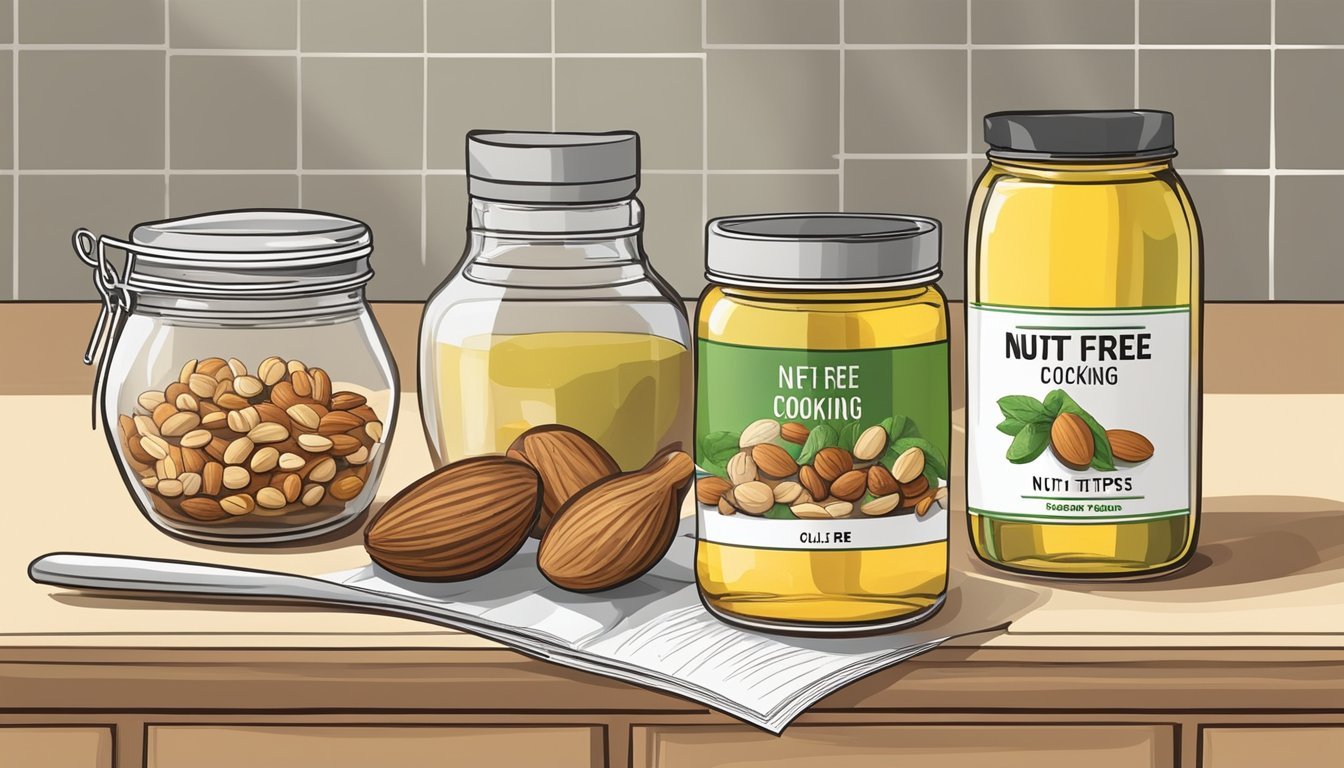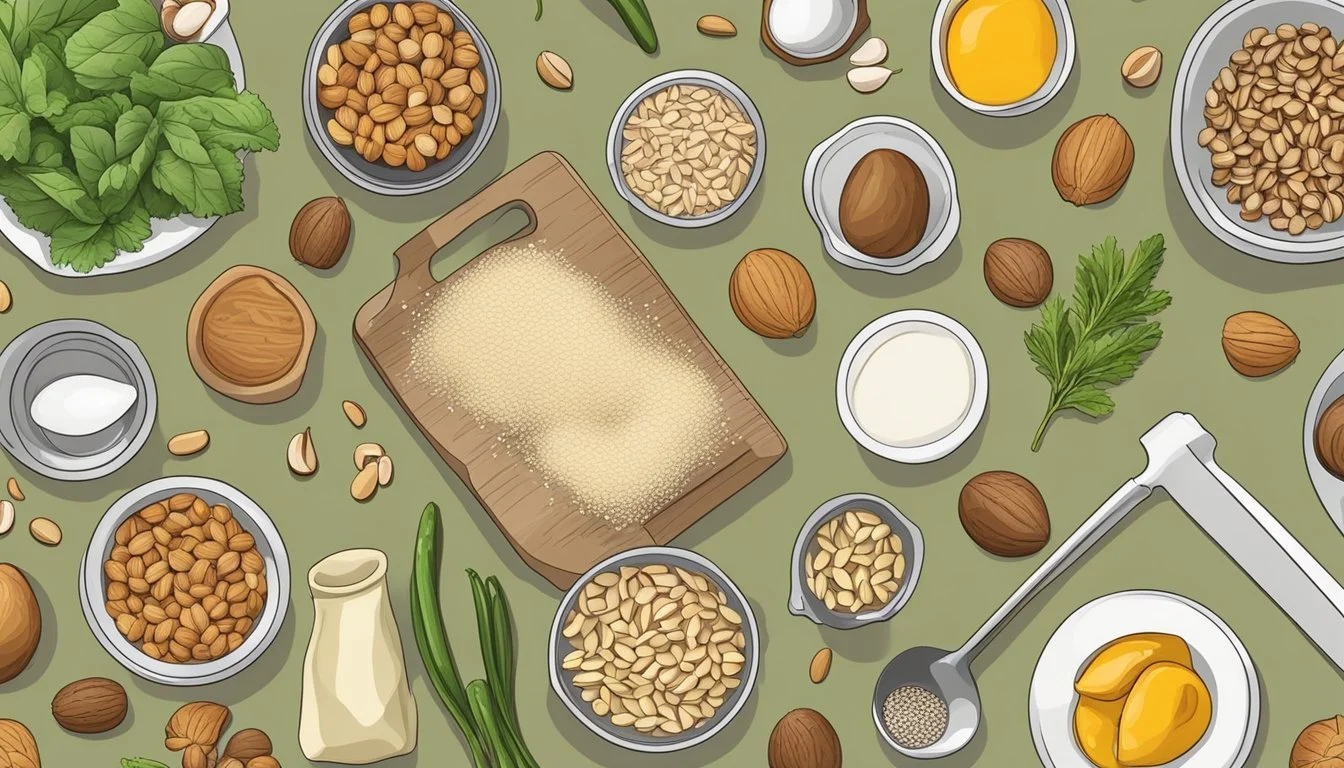How to Cook When You're Allergic to Nuts
Safe and Delicious Alternatives
Cooking with nut allergies involves navigating the kitchen with a keen understanding of ingredients, as even trace amounts of nuts (What wine goes well with nuts?) can trigger an allergic reaction in susceptible individuals. This type of food allergy is an immune system response to proteins found in nuts, ranging from peanuts—a legume that often presents similarly in allergies—to various tree nuts such as almonds, cashews, and walnuts. Individuals with nut allergies must be vigilant about the foods they consume and the potential for cross-contamination.
To manage a nut allergy effectively, it's crucial to know not only which foods typically contain nuts but also which items could be at risk due to cross-contact during processing. Safe cooking practices start with thorough label reading, since nuts can be present in unexpected products, and extends to careful preparation methods to avoid allergen exposure. Nut allergies can lead to serious health consequences, so understanding how to maintain a nut-free environment is essential.
Ingredients such as nut butters, pastes, and oils commonly found in recipes must be replaced with safe alternatives when cooking for someone with a nut allergy. Awareness and education can ensure a variety of nutritious and enjoyable meals without putting anyone’s health at risk. By adhering to strict ingredient guidelines and maintaining diligent kitchen protocols, those with nut allergies can have confidence in their meals being both delicious and safe.
Identifying Nut Allergies
When addressing the challenge of cooking with nut allergies, awareness and knowledge about the types of nuts that cause allergies, their symptoms, and the methods for diagnosis are crucial.
Common Nut Allergens
Nuts can be broadly categorized into two groups: peanuts and tree nuts. Peanuts are legumes that grow underground; however, their allergenic properties are akin to nuts. Common tree nuts include almonds, Brazil nuts, cashews, hazelnuts, pecans, pistachios, and walnuts. Even though coconuts are classified as fruit, some individuals with tree nut allergies may also react to coconut; nevertheless, this is uncommon.
Symptoms of Nut Allergies
The range of allergy symptoms can be wide. Minor reactions might involve itching, watery eyes, and a scratchy throat. More severe allergic reactions can encompass stomach pain, nausea, coughing, sneezing, and diarrhea. In certain cases, exposure to nuts can lead to anaphylaxis, a serious allergic reaction that is rapid in onset and may cause death.
Severity Symptoms Mild to Moderate Itching, watery eyes, scratchy throat Moderate to Severe Coughing, sneezing, stomach pain, nausea, diarrhea Anaphylaxis Difficulty breathing, drop in blood pressure, loss of consciousness
Diagnosing Nut Allergies
Allergists are medical professionals specializing in diagnosing and treating allergies, including food allergies such as nut allergies. Through patient history, skin prick tests, or blood tests to measure specific immune system responses, allergists can identify allergies to specific nuts. The presence of histamine releases during an allergic reaction can also aid in the diagnosis.
Understanding Nut Allergens
When cooking with nut allergies, it is critical to recognize specific allergens and understand the importance of vigilance with food labels, foods to avoid, and cross-contamination risks.
Reading Food Labels
Food labels are an essential tool for those with nut allergies, serving as the first line of defense. By law, food manufacturers must list all major food allergens, including tree nuts and peanuts. It's imperative to review ingredients for specific nuts like cashews, almonds, walnuts, pecans, pistachios, hazelnuts, macadamia nuts, Brazil nuts, and pine nuts. Additionally, look for phrases such as "may contain nuts" or "processed in a facility with nuts," which indicate potential cross-contamination risks.
Common Foods to Avoid
Individuals with nut allergies should be cautious of several common food items. This list includes, but is not limited to:
Cereals and granola containing nuts
Trail mix
Chili and soups (which may use nuts as thickeners)
Grain breads with nuts
High-energy bars
Certain international cuisines that commonly use nuts as ingredients
It is also wise to avoid spices such as cumin or spice blends, as these can contain nuts or be cross-contaminated.
Cross-Contamination Concerns
Cross-contamination can occur in several ways and presents a hidden danger for those with nut allergies. Cooking surfaces, utensils, and kitchen appliances must be thoroughly cleaned if they have been in contact with nuts. When dining out, it is crucial to communicate nut allergies to the staff to ensure they take appropriate measures to prevent contamination. In shared facilities, even trace amounts of nuts can trigger allergic reactions. Therefore, strict protocols must be in place to avoid exposure.
Safe Cooking Practices
When cooking with a nut allergy, it is essential to establish a safe environment, find suitable alternatives for nuts in recipes, and rigorously prevent cross-contamination.
Creating a Nut-Free Kitchen
One's kitchen should be thoroughly inspected to ensure that it is free from nuts and nut-containing products. Foods and ingredients should be checked for labels stating "may contain nuts" or "produced on equipment that also processes nuts". Appliances, utensils, and surfaces must be meticulously cleaned to remove any nut residues.
Inspecting Food Labels: Always read labels for hidden nuts in products like cereals, granola, and energy bars.
Cleaning Protocol: Regularly clean all surfaces, utensils, and appliances with soap and water or suitable cleaners to remove potential allergens.
Substituting Nuts in Recipes
Substitutions can be made for nuts in recipes to maintain flavor and texture without the risk of allergic reactions. For instance, seeds like pumpkin or sunflower can be used in place of nuts for crunch, while for nut butters, alternatives like tahini or sunflower seed butter may be ideal.
Crunchy Substitutes: Use seeds, pretzels, or roasted chickpeas.
Buttery Substitutes:
Nut Butter → Seed Butter (e.g., sunflower, pumpkin)
Pesto → Olive oil-based version with herbs
Preventing Cross-Contamination at Home
Cross-contamination can occur when allergens are transferred from one food or surface to another. It is crucial to use separate cooking and serving utensils for nut-free foods and to store nut-free ingredients separately from potential allergens.
Separate Utensils: Dedicate specific kitchen tools for nut-free cooking.
Storage: Keep nut-free ingredients in marked containers away from potential contaminants.
Cookware Caution: Avoid using porous materials like wood, which can absorb and retain allergens.
Nut-Free Alternatives
Navigating the kitchen and grocery aisles can be challenging for those with nut allergies, but a plethora of safe and delicious products and substitutions make cooking and eating both enjoyable and worry-free.
Shopping for Nut-Free Products
When looking for nut-free products, it is crucial to read labels carefully. Manufacturers often label foods that are safe for nut allergy sufferers with phrases like "nut-free" or specific declarations stating the absence of nut ingredients. It's also essential to look for cross-contamination warnings, which indicate that the product may have been produced in a facility that processes nuts. For cooking essentials such as butter and sauces, seek brands that manufacture exclusively nut-free items to avoid cross-contamination risk.
Chocolate and Candies: Select chocolate labeled as nut-free, and for candies, avoid those that list any kind of nut or warning of potential nut contamination.
Cookies and Baking: Find brands that produce exclusively nut-free baked goods, or use nut-free labeled flours and baking mixes.
Frozen Desserts: Choose nut-free labeled ice creams or make homemade frozen desserts using safe ingredients.
Nut Substitutes in Common Dishes
Substituting nuts in recipes requires finding alternatives that offer similar texture and nutritional value.
Salads: Crunch can be added with seeds like pumpkin or sunflower, or even roasted chickpeas.
Soups: To thicken soups traditionally using nuts, one can utilize pureed beans or potatoes.
Sauces: For a creamy texture without nuts, incorporate coconut milk or tahini (sesame seed paste).
Nougat and Candy: Seeds can mimic the crunch of nuts in candies; sunflower seed butter is a great alternative in nougats.
Here's a brief table illustrating common nut-containing foods and their possible substitutes:
Nut-Containing Food Nut-Free Substitute Pesto (with pine nuts) Pesto with seeds or legumes Peanut butter (sandwiches, sauces) Seed butters (e.g., sunflower) Almonds (snacks, salads) Roasted chickpeas or pretzels Peanut sauce Coconut milk or seed-based sauce
Cooking without nuts doesn't mean missing out on flavor or texture; with these alternatives, meals can be just as rich and satisfying.
Managing Nut Allergies Outside the Home
When someone with a nut allergy is eating outside the home, diligence is key. One must be vigilant in restaurants, prepared during travel, and always ready for emergency situations.
Navigating Restaurants
Individuals should always inform wait staff about their nut allergy upon arrival at a restaurant. It is important to ask about cross-contamination practices and to avoid dishes that could potentially contain nuts, even as hidden ingredients. One should look for:
Clear labeling on menus
Restaurants with allergy-friendly policies
Communication with chefs about specific needs
One can also consider using smartphone apps that can help identify allergy-friendly dining options.
Travel Tips for Nut Allergies
Travel requires extra planning for those with nut allergies. They should pack safe meals and snacks to avoid being caught without options. Here are some tips:
Carry multiple epinephrine auto-injectors (e.g., EpiPen®), especially on long trips where pharmacies may not be accessible
Keep a medical alert bracelet visible at all times
Understand and translate allergy information if traveling to a country with a different primary language
Research airlines' policies on nut allergens, as some may serve nuts or meals that contain nut derivatives
Emergency Preparedness
One must always be ready to respond to accidental exposure. Individuals should:
Carry an epinephrine auto-injector at all times, as this is the first line of treatment for severe allergic reactions (anaphylaxis)
Educate travel companions on recognizing signs of an allergic reaction and how to use the auto-injector
Keep an updated anaphylaxis action plan that outlines steps to take in the event of a reaction, and ensure it is easily accessible
Understanding the signs of anaphylaxis and acting quickly can be the difference between a manageable reaction and a life-threatening situation.
Nut Allergy Medical Management
Managing a nut allergy effectively requires understanding the critical role of emergency medications and the importance of regular specialist consultations. Immediate and appropriate medical responses can significantly reduce the risks associated with allergic reactions.
Understanding Epinephrine Administration
When a person with a nut allergy is exposed to nuts, their immune system mistakenly identifies the proteins as a threat, releasing antibodies and histamines that can lead to an allergic reaction. Epinephrine is the first-line treatment for severe allergic reactions, also known as anaphylaxis. It works by rapidly reducing the body's allergic response, countering the effects of histamines, and improving breathing. Patients must carry an epinephrine auto-injector at all times and be proficient in its use, as timely administration is crucial.
To administer epinephrine:
Remove the auto-injector from the safety case.
Place the tip against the outer thigh.
Press firmly until the injector activates, which is typically indicated by a ‘click’ sound.
Hold in place as directed by the product instructions, usually about 10 seconds.
Remove the injector and massage the injection area for 10 seconds to enhance absorption.
Regular Check-ups With Your Allergist
Regular visits to an allergist are essential for the ongoing management of a nut allergy. An allergist can perform tests to monitor the condition and review the effectiveness of the allergy management plan. These check-ups often include:
Assessment of the immune system's response to nuts: The allergist may conduct skin-prick tests or blood tests to measure specific nut-related antibodies.
Medication review: Ensuring that the patient has an up-to-date prescription for epinephrine and understands when and how to use it.
Education on avoiding exposure: Discussing avoidance strategies including reading labels, recognizing cross-contamination risks, and safe alternatives for cooking and eating.
Through these specialized assessments, the allergist offers individual guidance to manage the allergy, providing the patient with confidence in their daily life.






